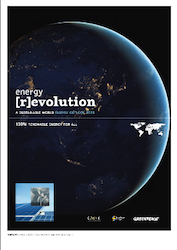According to a new Greenpeace report, “2015 Energy [r]evolution,” the world could be fueled by 100 percent renewable energy by 2050. The analysis, researched in collaboration with the German Aerospace Centre (DLR), finds that the transition to renewables would not only create jobs but be cost competitive. The necessary investment in clean energy, the report states, would be more than covered by future savings in fuel costs.
 “The phase out of fossil fuels and transition to renewable energy is not only needed, but can be achieved globally by mid-century,” said Greenpeace USA Climate and Energy Campaign Director Kelly Mitchell. “In the US, we must prioritize keeping coal, oil and gas in the ground while accelerating the transition to clean energy like wind and solar. Doing so would both create new jobs and ensure a healthier planet for future generations.”
“The phase out of fossil fuels and transition to renewable energy is not only needed, but can be achieved globally by mid-century,” said Greenpeace USA Climate and Energy Campaign Director Kelly Mitchell. “In the US, we must prioritize keeping coal, oil and gas in the ground while accelerating the transition to clean energy like wind and solar. Doing so would both create new jobs and ensure a healthier planet for future generations.”
All eyes will be on Paris this December when world leaders will meet to discuss ongoing efforts to curb climate change. The report finds that globally, average additional investment needed in renewables is roughly $1 trillion a year until 2050. Because renewables don’t require fuel, the savings over the same period would be $1.07 trillion a year, which more than covers the costs of the required investment states the study.
“We must not let the fossil fuel industry’s lobbying stand in the way of a switch to renewable energy, the most effective and fairest way to deliver a clean and safe energy future,” said Greenpeace International Executive Director Kumi Naidoo. “I urge all those who say ‘it can’t be done’ to read this report and recognize that it can be done and must be done for the benefit of people around the world.”
Within 15 years, renewables’ share of electricity could triple from 21 percent to 64 percent, which would ensure almost two thirds of global electricity supply is delivered from clean energy. Despite the rapid development of countries like Brazil, China and India, CO2 emissions could fall from the current 30 gigatonnes a year to 20 gigatonnes by 2030.
The report also finds that the solar PV industry could employ 9.7 million people by 2030. In the U.S., there are already twice as many solar workers as coal miners. “The solar and wind industries have come of age, and are now cost competitive with coal,” said Greenpeace’s Sven Teske, the lead author of the report. “It is very likely they will overtake the coal industry in terms of jobs and energy supplied within the next decade. It’s the responsibility of the fossil fuel industry to prepare for these changes in the labor market and make provisions. Every dollar invested in new fossil fuel projects is high risk capital which could end up as stranded investment.”
Naidoo concluded, “Following this Greenpeace scenario, the Paris climate agreement must deliver a long term vision for phasing out coal, oil, gas and nuclear energy by mid-century, reaching the goal of 100% renewables with energy access for all.”

